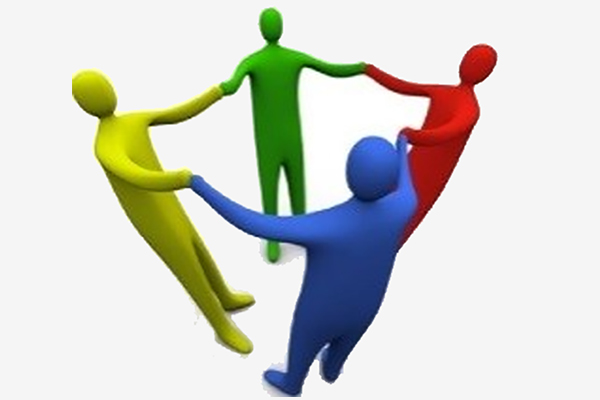
Social Wellness
Your behavior is influenced by others far more strongly than you might think, even by people you have never met. Recent research shows that our moods are far more strongly influenced by those around us than we tend to think. Not only that, we are also beholden to the moods of friends of friends, and of friends of friends of friends: peo-ple three degrees of separation away from us who we have never met, but whose dispo-sition can pass through our social network like a virus.
Indeed, it is becoming clear that a whole range of phenomena are transmitted through networks of friends in ways that are not entirely understood: happiness and depression, obesity, drinking and smoking habits, ill-health, the inclination to turn out and vote in elections, a taste for certain music or food, a preference for online privacy, even the tendency to attempt or think about suicide. They ripple through networks “like pebbles thrown into a pond”, says Nicholas Christakis, a medical sociologist at Harvard Medical School in Boston, who has pioneered much of the new work.
At first sight, the idea that we can catch the moods, habits and state of health not only of those around us, but also those we do not even know seems alarming. It implies that rather than being in charge of where we are going in life, we are little more than backseat drivers, since most social influence operates at a subconscious level.
But we need not be alarmed, says Duncan Watts, a sociologist at Columbia University, New York. “Social influence is mostly a good thing. We should embrace the fact that we are inherently social creatures and that much of whom we are and what we do is deter-mined by forces that are outside the little circle we draw around ourselves.” What is more, by being aware of the effects of social contagion, we may be able to find ways to counter it or use it to our own benefit. “There are no doubt people can have some con-trol over their networks and that this in turn can affect their lives,” says Christakis.
But we need not be alarmed, says Duncan Watts, a sociologist at Columbia University, New York. “Social influence is mostly a good thing. We should embrace the fact that we are inherently social creatures and that much of whom we are and what we do is determined by forces that are outside the little circle we draw around ourselves.” What is more, by being aware of the effects of social contagion, we may be able to find ways to counter it or use it to our own benefit. “There are no doubt people can have some control over their networks and that this in turn can affect their lives,” says Christakis.
Actions and feelings can be as contagious as a virus.
Happy people tend to be clustered together, not because they naturally orientate towards each other, but because of the way happiness spreads through social contact over time, regardless of people’s conscious choice of friends. A person’s happiness is dependent not only on the happiness of an immediate friend, but to a lesser degree on the happiness of their friend’s friend, and their friend’s friend’s friend. Furthermore, someone’s chances of being happy increase the better connected they are to happy peo-ple, and for that matter the better connected their friends and family.

Happiness is near
It is found that the effect is not the same with everyone you know. How susceptible you are to someone else’s happiness depends on the nature of your relationship with them. For example, if a good friend who lives within a couple of kilometers of you sud-denly becomes happy, that increases the chances of you becoming happy by more than 60 per cent. In contrast, for a next-door neighbor the figure drops to about half that, and for a nearby sibling about half again. Surprisingly, a cohabiting partner makes a difference of less than ten per cent, which coincides with another peculiar observa-tion about some social epidemics: that they spread far more effectively via friends of the same gender.
All this poses a key question: how can something like happiness be contagious? Some researchers think one of the most likely mechanisms is empathetic mimicry. Psycholo-gists have shown that people unconsciously copy the facial expressions, manner of speech, posture, body language and other behaviors of those around them, often with remarkable speed and accuracy. This then causes them, through a kind of neural feed-back, to actually experience the emotions associated with the particular behavior they are mimicking. Researchers have found that the stronger the facial expression, the stronger the emotion experienced by the person observing it. It is believed that this process is hardwired, since it acts so rapidly and automatically.
It has been suggested that that this mechanism works through the action of mirror neurons, a type of brain cell thought to fire both when we perform an action and when we watch someone else doing it, though it is not clear whether the mimicking would cause the neurons to fire or whether their firing would trigger the mimicry. What is clear is that unconscious imitation allows people to “feel a pale reflection of their com-panions’ actual emotions” and even “feel themselves into the emotional lives of others”. In 2000, Peter Totterdell at the University of Sheffield, UK, found a significant asso-ciation between the happiness of professional cricketers during a match and the aver-age happiness of their teammates, regardless of other factors such as whether the match was going in the team’s favor (Journal of Applied Psychology, vol 85, p 848). He found a similar effect among nurses and office workers. It has also been shown that if a college student suffers from mild depression their roommate will become progres-sively more depressed the longer they live with them, and that emotional displays by bank employees have a direct impact on the moods of their customers.
We can see, then, how a phenomenon such as happiness might pass quickly through a social network and infect clusters of friends and relatives. What none of these studies explains, however, is why the strength of the infection varies according to who is pass-ing it to whom. Why are we so much more strongly affected by the happiness of a nearby friend than a nearby sibling? Why does a next-door neighbor have a significant impact, yet someone living a few tens of meters away on the same block have none?

The power of strangers
Two factors appear crucial: the frequency of social contact, and the strength of the relationship. This is not too surprising: we know that emotional contagion requires physi-cal proximity. It is also likely that the closer we feel to someone, the more empathetic we are towards them, and the more likely we are to catch their emotional state.
However, how these two factors play out in day-to-day interactions is uncertain. What is also unclear – because it has never been properly tested – is the extent to which emotions can propagate through virtual networks, where the opportunity for physiologi-cal mimicry is much reduced.
So much for emotions – what about other phenomena that we unwittingly pick up, and pass on, through our social networks? In 2007, Christakis team, again tracking members of the Framingham Heart Study, found that obesity is transmitted in a similar way to happiness. Your risk of gaining weight increases significantly when your friends gain weight and it is also affected by the weight of people beyond your social horizon. Again, how likely you are to catch it depends on who you are interacting with: after controlling for factors such as difference in socioeconomic status, the researchers found that an individual’s chances of becoming obese increased by 57 per cent if one of their friends became obese, 40 per cent if a sibling did and 37 per cent if their spouse did, irrespective of age (The New England Journal of Medicine, vol 357, p 370).
However, neighbors have no influence, and how far away you live from a friend counts for little, which implies that obesity spreads via a different mechanism to happiness. Rather than behavioral mimicry, the key appears to be the adoption of social norms. One similarity with happiness is that friends and relatives have a far greater influence if they are of the same gender. While it is not evident why that should matter for emotional contagion, norms of body size are clearly gender-specific:” Women look at other women, men look at other men,” says Christakis. This could also help explain the epidemics of eating disorders reported among groups of schoolgirls in recent decades.
The spread of a social norm appears to account for another of Christakis’s findings: that when people stop smoking, they usually do so along with whole clusters of friends, relatives and social contacts. As more people quit, it becomes the socially acceptable thing to do, and those who choose to continue smoking are pushed to the periphery of the network. In this case, people are most strongly influenced by those closest to them – if your spouse quits, it is 67 per cent more likely that you will too. Your work col-leagues can also have an effect, particularly if you are in a small, close-knit workplace; and more highly educated friends influence one another more than less educated (The New England Journal of Medicine, vol 358, p 2249).
Happiness, obesity, smoking habits – activities that we traditionally think of as shaped by individual circumstances, turns out to be ruled to a large degree by social forces many other day-to-day phenomena fit a similar pattern, often counter-intuitively.
Happiness, obesity, and smoking habits – all turn out to be ruled to a large degree by social forces.”
Take autism: Peter Bearman at the Institute for Social and Economic Research and Pol-icy at Columbia University who in 2004 uncovered a link between suicidal behavior and certain friendship patterns (American Journal of Public Health, vol 94, p 89), is looking at whether the recent rise in the diagnosis of autism is in any way socially determined. His study is ongoing, but he says his findings could be “explosive”. “It is likely that if you have an autistic child in your community the probability of your child being diagnosed with autism is significantly higher.”
Why three degrees?
While the mechanism of social contagion varies depending on the phenomenon being spread, in many cases the dynamics are very similar. For example, Christakis has found that with happiness, obesity and smoking habits, the effect of other people’s behavior carries to three degrees of separation and no further. He speculates that this could be the case with most or perhaps all transmissible traits. Why three degrees? One theory is that friendship networks are inherently unstable because peripheral friends tend to drop away. “While your friends are likely to be the same a year from now, your friends of friends of friends of friends are likely to be entirely different people,” says Christakis.
This poses the question: what shapes the architecture of our social networks and our position in them? Clearly, many factors contribute: where we live, where we work, family size, education, religion, income, our interests, and our tendency to gravitate towards people similar to us. New research by Christakis’s team, due to be published in the next few weeks, suggests there is also a strong genetic component. The study compared the social networks of identical and fraternal twins, and found that identical twins had significantly more similar social networks than fraternal twins, suggesting the structure of your social network is influenced by your genes. That may not sound remarkable, since personality traits such as gregariousness and shyness clearly play a role in deter-mining how connected we are. But there is much more to it, says Christakis. “It is not just about having a genetic predilection to be friends with a lot of people; it is about having a genetic predilection to be friends with a lot of popular people. That is mysteri-ous: how could our genes determine our actual location in this socio-topological space?”
Answering that should help us understand more about the “collective intelligence” of social networks, which some researchers liken to the flocking of birds – the decision to quit smoking, for example, is no more an isolated move than the decision by a bird in a flock to fly to the left.
Sociologists and others are using mathematical models to test these dynamics to try to understand better what triggers the spread of behaviors. Duncan Watts at Columbia University has shown that seeding localized social groups with certain ideas or behaviors can lead to the ideas cascading across entire global networks. This contradicts the notion – promoted by the author Malcolm Gladwell in The Tipping Point and others – that social epidemics depend on a few key influential individuals from whom everyone else takes their cue. It does not ring true, argues Watts, because such “influential” typi-cally interact with only a few people. The key for the spread of anything, he says, from happiness to the preference for a particular song, is a critical mass of interconnected individuals who influence one another.
Is there any way to mitigate the effects of such powerful and pervasive social forces? It is unlikely we can ever escape social influence entirely, even if we wanted to.
“Even when you are aware of it, you are probably susceptible,” says Watts. Still, being aware can help, especially when we are seeking to avoid undesirable behaviors or adopt positive habits. We can be choosy about new friends, seeking out people whose lifestyles we aspire to: if you want to lose weight, for example, join a running club and – most importantly – socialize with its members.
Actually cutting ties with old friends might be a bit drastic, though perhaps spending less time with those whose traits we do not wish to share would be a good idea – lazy people, perhaps, or those inclined to negative thinking. And beware those who hang out with such people even if they do not display their views or behaviors – remember the three degrees of contagion rule. Finally, if you really cannot avoid spending time with certain people whose behaviors or emotional state you would rather not take on board (certain relatives at family gatherings, perhaps), you could always try repressing your natural inclination to mimic their body language and facial expressions, and so limit the contagion effect – though be prepared for them to instinctively cool towards you as a result.
What this game plan amounts to is a kind of subtle social reorientation. We will always be vulnerable to what those around us are doing, so as far as possible make sure you are with the right people.
Remember the new adage: we are who we hang out with.